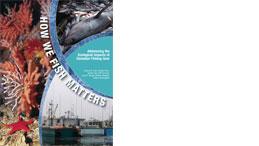New report ranks destructive impacts of fishing gear used in Canada
Immediate action needed to protect habitat and marine life
Sointula, B.C. and Halifax, N.S. - A new national study recommends that Fisheries and Oceans Canada immediately implement policies that prioritize the protection of habitat and marine life as well as provide incentives to fishermen to switch to less harmful fishing gear. This study, entitled How We Fish Matters: Addressing the Ecological Impacts of Canadian Fishing Gear, ranks the impacts of 13 different gear types used in Canada, from bottom trawls to lobster traps. The study, released by the Living Oceans Society, Ecology Action Centre, and Marine Conservation Biology Institute, also recommends that adequate monitoring, research and data collection on fishing gear impacts be undertaken and that proper planning and implementation of marine protected areas occur.
“Currently, some types of fishing gear are destroying critical habitats such as coral forests and sponge fields while the use of other gear results in high bycatch and discard levels of non-target species,” says Susanna Fuller of the Ecology Action Centre. “Fisheries managers can help fishermen transition to less harmful gear by providing preferential access to fishing grounds and quota allocations in favour of fishing methods that are less harmful to the marine environment.”
The study was completed in three stages, starting with a review of all existing scientific studies on impacts of fishing gear; a rating of the impacts of fishing gear by fishermen, scientists, and conservation professionals; and finally a survey of 97 professionals from different sectors working with fisheries where respondents ranked the ecological impacts of 13 different gear types.
“Using the results of this data driven report, fisheries managers, fishermen, and stakeholders can work together to identify where and how fishing should occur.” says Jennifer Lash, Executive Director of Living Oceans Society. “This should be done through the marine planning processes that DFO is initiating on all three coasts, as well as through renewed fisheries management plans.”
The most severe ecological impacts were associated with bottom trawl gear. Bottom gillnets, dredges and bottom longlines followed in the ranking of impact severity. Pots and traps, such as those used to catch lobster and crab, had intermediate ecological impacts. Fishing gear with low impacts included hook and line such as rod and reel for tuna, salmon troll and hand lining for groundfish. The gear with the lowest impact overall was the swordfish harpoon, which is still used on Canada’s east coast.
“Clearly, the harpoon is a much more selective fishing method than pelagic longlines, but fisheries managers don’t appear to use this information in catch allocation decisions”, notes Dr. Lance Morgan of Marine Conservation Biology Institute.
“One of the most interesting findings of our report is that fishermen, fisheries managers, scientists and conservation organizations all agreed on the level of impacts caused by different fishing gears,” says Dr. Ratana Chuenpagdee of Memorial University in Newfoundland, one of the report’s authors. “This consensus provides an important basis from which we can move forward in improving fisheries management and protecting our marine environment to ensure sustainable fisheries into the future.
-30-
Contactez-nous
Jennifer Lash, Executive Director, Living Oceans Society, (604) 696-5044
Susanna Fuller, Marine Conservation Director, Ecology Action Centre, (902) 446-4840
Lance Morgan, Vice President for Science, Marine Conservation Biology Institute, (707) 938-3214
Ratana Chuenpagdee, Canada Research Chair in Natural Resource Sustainability and Community Development, Memorial University
Background
New study ranks fishing gears used in Canada according to their impacts on habitat and incidentally-caught and discarded species.
1. Primary Result: Gear Ranking
Bottom trawl, bottom gillnet, dredge, and bottom longline are the gears that cause the greatest impacts on habitat and discarded bycatch. Harpoon, dive, and hook and line are the fishing methods that result in the least impacts on habitat and discarded bycatch.
2. Other Key Results
- East- and west-coast fishermen, fisheries scientists, managers and conservation professionals who participated in the study’s survey were consistent in their rankings of the fishing gears (see below). Despite the frequently contentious nature of fisheries management decisions, the study found that these groups of stakeholders share similar judgements regarding the impacts of fishing gear on habitat and the amount of discarded bycatch. This is an important result as it provides a common place from which to begin building a new vision for Canada’s fisheries.
- The primary concern of respondents was the impacts of fishing gear on habitat.
- There are significant data gaps in many Canadian fisheries with regards to habitat damage and bycatch.
3. Recommendations
Based upon the results of this study, the Ecology Action Centre, Living Oceans Society, and Marine Conservation Biology Institute make the following recommendations to the government of Canada:
1. Fisheries managers should immediately implement management strategies to minimize the impacts of fishing gear on habitat and bycatch; including habitat protection, and access to fishing grounds and quota allocations based on gear substitution.
2. Adequate monitoring, research and data collection on fishing gear impacts to habitat and non-target species must be undertaken, and made publicly available, to support ecosystem and spatial management practices.
3. Implement, inform and develop policies and management practices that prioritize the minimization of habitat destruction and incidental catch and discarding of target and non-target species.

